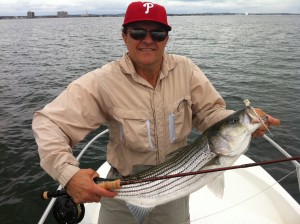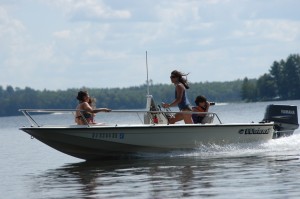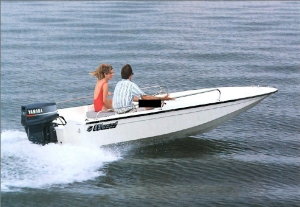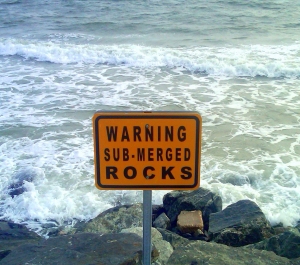







A site dedicated to discussion of these classic boats
11 Oct, 2011 No Comments
 It rained the other night in Boston. Or said another way…it RAINED the other night in Boston. Six inches in two hours! At times the rain was so loud it sounded like a freight train. I lay in bed listening and smiling, thinking of my Wahoo! in its slip, warmed by the thought of the two bilge pumps I’d installed this past year (one in the deck drain basin and one in the true bilge), doing their job. No worries.
It rained the other night in Boston. Or said another way…it RAINED the other night in Boston. Six inches in two hours! At times the rain was so loud it sounded like a freight train. I lay in bed listening and smiling, thinking of my Wahoo! in its slip, warmed by the thought of the two bilge pumps I’d installed this past year (one in the deck drain basin and one in the true bilge), doing their job. No worries.
Until I remembered that the day before I’d taken the battery out of the boat and brought it home to charge it. Shoot.
It being a weekday, I had to go to work that morning and couldn’t check on the boat until later. All day I wondered if I’d find it full of water up to the gunnels or worse. It wasn’t though. I walked out onto the dock that evening to find it bobbing in its slip. Well not bobbing, exactly. Actually the stern was sitting pretty low in the water. I hooked up the battery and the pumps went to work, removing about 100 gallons of water, most of it from below deck.
Once the season is over and I have more time I’ll write a lot more about the Wahoo!s plumbing…the supposedly self-bailing system, the deck drain, the true bilge, what drains into where and so on. It’s one of the most confusing aspects of these boats and one of the most asked about by Wahoo! owners. For now, though, I’ll just say that in my (limited) experience: A) If you keep your Wahoo! in the water you most definitely need a bilge pump, and quite likely two; B) Even if you don’t keep it in the water you may prefer a pump in the deck drain basin to Wahoo!s self-bailing design; and C) Rule pumps…ummm….rule. They are rugged, dependable workhorses. And made right here in the great state of Massachusetts. ![]()
30 Sep, 2011 No Comments
Filed in: uncategorized
 One of the projects for the off-season will be exploring ways to get the nose of the boat down more when underway. One approach will be to investigate ways to get the boat up on plane a little faster; I’m currently reading the pros and cons of adding a hydrofoil to the outboard.
One of the projects for the off-season will be exploring ways to get the nose of the boat down more when underway. One approach will be to investigate ways to get the boat up on plane a little faster; I’m currently reading the pros and cons of adding a hydrofoil to the outboard.
Another approach will be to investigate weight reduction or redistribution. Weight, especially in the rear of the boat, has been causing me problems two ways: the first is the high bow when underway and not on plane; the second is that when sitting in the slip the rear of the boat rides about an inch lower than the bottom paint covers, allowing a ring of marine growth around the stern. It didn’t do this when I fist got the boat but the new engine, with its extra cylinder and tilt/trim unit increased the engine weight by 70 pounds over the old one.
I could, of course, bring the bottom paint up another inch. Another idea I read today came from a Wahoo! owner who brought the battery forward from its traditional (on a Wahoo! 16) location in one of the stern compartments to inside the console. That would move about 30 to 35 pounds forward. Of course, it might also require a pretty fair amount of rewiring. Or maybe not. Something to ponder on a long, snowy night.
24 Sep, 2011 2 Comments
Filed in: fishing
 Baptized Seatoad as a fishing boat with its first fish today. With my friend Gary Cwyk of Philadelphia on a warm September afternoon, we went cruising looking for birds. We found them off Revere Beach, working over a mix stripers and bluefish. In the next couple of hours we caught both, most around 30 inches long with a few bigger ones. At times the boat was surrounded by boiling fish.
Baptized Seatoad as a fishing boat with its first fish today. With my friend Gary Cwyk of Philadelphia on a warm September afternoon, we went cruising looking for birds. We found them off Revere Beach, working over a mix stripers and bluefish. In the next couple of hours we caught both, most around 30 inches long with a few bigger ones. At times the boat was surrounded by boiling fish.
Nice.
24 Sep, 2011 No Comments
Filed in: models and trim lines
 In April 2010 a Hull Truth poster by the name of jojola posted a message offering his 1990 Wahoo 1650 Striper for sale. The message came complete with pictures. It was such a beautiful boat, so well maintained and outfitted, that I wanted to repost a lot of the info here (including the pictures) as a source of ideas for other Wahoo owners.
In April 2010 a Hull Truth poster by the name of jojola posted a message offering his 1990 Wahoo 1650 Striper for sale. The message came complete with pictures. It was such a beautiful boat, so well maintained and outfitted, that I wanted to repost a lot of the info here (including the pictures) as a source of ideas for other Wahoo owners.
Here’s a gallery of pictures of the boat.
The text below is jojola’s, with a few minor edits by me…
Very clean 1990 Wahoo 1650 Striper
New 2007 Yamaha 90TLR (purchased 2008) still under warranty and YES eligible – 40 hours of use
All new Yamaha rigging, 704 Controller, Key switch, Harness
New Yamaha Digital Gauges
New Dash with New Switches
New main power switch
New center console frame and door
New Taco rod holders
New Starboard Cover Plates
New Yamaha 10 Micron Fuel/Water Separator
New Sump well automatic pump
New Small recirculation bait well (no water pick-up)
New fuel line
New battery
2 New rear pull up cleats
New removable swivel-eze ski pylon
2 New console seat mounted rod holders
New Jensen 2007 Stereo/Speakers with Ipod cable
New Standard Horizon VHF and Digital VHF Antenna
New Eagle Elite GPS / Sonar w/East Coast chart
New Swim Platform
New Horn
New LED cockpit lights
New Taylor Boat Cover – Trailerable
Original Bimini Top
New Anchor/Rode/SS Chain
New Powertech SCD-4, 4-blade SS prop
This boat was a project that my son and I worked on for well over a year, unfortunately I must now sell her. The history of this boat is I’m the second owner. This boat has the original Wahoo registration card. It comes with all manuals and Yamaha service guide. It has only been used in saltwater once, it’s whole life it was a fresh water boat. After every use the motor gets flushed, and before storage the carb’s are run dry and then drained, lower unit oil changed, and motor fogged.
17 Sep, 2011 No Comments
Filed in: models and trim lines, servicing
 A pretty common question about Wahoos goes something like, “I just bought a sixteen foot 1989 Wahoo. Which model is it?” I had the same question myself immediately after buying my boat. And Wahoo itself changed model names and trim lines year to year, adding to the confusion. So here’s a disambiguation on sixteen foot Wahoos…
A pretty common question about Wahoos goes something like, “I just bought a sixteen foot 1989 Wahoo. Which model is it?” I had the same question myself immediately after buying my boat. And Wahoo itself changed model names and trim lines year to year, adding to the confusion. So here’s a disambiguation on sixteen foot Wahoos…
Models
First there are the models. From 1985 to 1989 the only sixteen foot Wahoo model was the 16.2, named for its sixteen feet two inch centerline. (It was also six feet two inches wide, so the name described both the boat’s length and beam.) In 1990 Wahoo models of all lengths went through a renaming (possibly to make them sound a little sexier). The 16.2 was renamed the 1650; same boat, same specs (including length), different model name.
In 1991 Wahoo introduced a deep V, air-chambered hull to its line of boats. These were identified by the appellation LX in the model name (the absence of LX in the name signified the existing, Whaler-styled hull). The initial sixteen foot deep V model offered in 1991 was named the 1650 LX.
The were two other short-lived sixteen foot Wahoos:
Trim Lines
In 1985, its initial year, Wahoo offered two trim lines of the 16.2: the LTD, a side console; and the Twin, a twin console. These were joined in 1987 by the Striper, a center console designed as a family fishing boat. Things were stable after that until 1992.
The following table summarizes the years the various Wahoo sixteen foot models/trim lines were in production.
| 1985 | 1986 | 1987 | 1988 | 1989 | 1990 | 1991 | 1992 | 1993 | 1994 | 1995 | 1996 | |
| 16.2/1650 LTD | ||||||||||||
| 16.2/1650 Striper, 1650 CC | ||||||||||||
| 16.2/1650 Twin, 1650 DC | ||||||||||||
| 1650 Lazer | ||||||||||||
| 1650 Lightening | ||||||||||||
| 1650 LX | ||||||||||||
| 1650 Striper LX | ||||||||||||
| 16.5 Special | ||||||||||||
| F-1600 EFS |
17 Sep, 2011 No Comments
Filed in: news

I just added two original Wahoo! brochures to the Downloads pages. These came thanks to Hull Truth subscriber Bo Neato.
The first is 1990 brochure showing the 1650, 1750, and 14.5/16.5 models. It includes a classic picture of a Wahoo with passengers aboard cut into three pieces (the boat, not the passengers) and still afloat.
The second is a 1994 document listing descriptions, specs, and available options for the 1250, 1450, 1650, 1750, and 2100 models. Note the typo in the section describing the “1650 Stripper.” ![]()
10 Sep, 2011 No Comments
Filed in: adventures, equipment
 Launched the boat today for the first time since pulling it out of the water for engine repairs four weeks ago (a story in itself for another time). I launched from the Nahant Town Wharf intending simply to test out the engine after the repairs and then dock at my slip at the Point of Pines Yacht Club two miles away. Wind was moderate out of the southeast and, as the tide was low and there are some rock piles along that route, I kept my speed down and my eye on the depth finder. After rounding Bass Point I headed out towards open water. The finder was showing a steady seven feet so I opened her up a little and suddenly BAM!!!! The whole boat shuddered and stopped. I didn’t know what happened…thought maybe a couple of the engine mount bolts failed–that’s how severe the shock was. But looking down over the side I saw right away I’d run onto a rock pile and had struck a large rock. I was in two to three feet of water but the depth finder still read seven feet. Killed the engine, titled it up, and sat there a little dumbfounded as the wind and current pushed me away from the rocks, feeling very sheepish and wondering just how badly I’d injured myself.
Launched the boat today for the first time since pulling it out of the water for engine repairs four weeks ago (a story in itself for another time). I launched from the Nahant Town Wharf intending simply to test out the engine after the repairs and then dock at my slip at the Point of Pines Yacht Club two miles away. Wind was moderate out of the southeast and, as the tide was low and there are some rock piles along that route, I kept my speed down and my eye on the depth finder. After rounding Bass Point I headed out towards open water. The finder was showing a steady seven feet so I opened her up a little and suddenly BAM!!!! The whole boat shuddered and stopped. I didn’t know what happened…thought maybe a couple of the engine mount bolts failed–that’s how severe the shock was. But looking down over the side I saw right away I’d run onto a rock pile and had struck a large rock. I was in two to three feet of water but the depth finder still read seven feet. Killed the engine, titled it up, and sat there a little dumbfounded as the wind and current pushed me away from the rocks, feeling very sheepish and wondering just how badly I’d injured myself.
As it turned out, the answer was bad but not as bad as it could have been. The edges of all three blades on the prop were dinged pretty good (but the blades themselves were not bent). The prop will need re-machining. But had I been going a little faster I could easily have taken out the lower unit. After drifting awhile I restarted the engine and gingerly put it into gear. I completed an hour of practice runs during which I confirmed that the depth finder is malfunctioning; it will read OK for a bit but then lock on a particular depth reading and stay on it until something causes it to start working again.
Later, docked safely at the Pines I told the story to Raybo (Ray M.) who’s been following my boat, ahem, issues, for the past year. “Damn Mike,” he says. “If it wasn’t for bad luck you wouldn’t have any luck at all.” Fishing tomorrow with Ben.
8 Sep, 2011 10 Comments
Filed in: models and trim lines
Although I’m writing this “first post” a year after the fact, it’s probably worth recording what my Wahoo was like when I first bought it, what I paid for it, and so on.
Specs
Model: Wahoo 16.2 Striper
Year: 1987
Length: 16 feet
Beam: 6 feet 2 inches
Weight: 725 pounds
Capacity: 5 persons or 634 passenger pounds; 1104 pounds including engine and gear
Horsepower: Rated up to 90 HP
Features: Built-in 12 gallon fuel tank; full rail; original wooden lids and cushions; console controls include tachometer, tilt/trim indicator, and speedometer
The boat came with a 2008 Load Rite bunk trailer rated for 1500 pounds in good shape, and a 1981 50hp 2 stroke Evinrude engine (without power tilt/trim). The previous owner said he’d had no problems with the engine but for me it was hard-starting and prone to stalling at idle almost from the get go. After the first few trips I had to spray gas directly into the carb to get it to start, even when it was warmed up.
Notably not present at the time of purchase was a bilge pump, depth finder, or working kill switch.
Condition
Overall for its age (23 years) the boat was in pretty good condition, although certainly not pristine. The rail and cushions were in great shape. The wood needed refinishing. The fiberglass was solid (although the bow lip was cracked from being winched too tightly onto the trailer a few times). The gel coat had numerous small chips and had long ago lost its shine; it scuffed and dirtied easily. Some of the deck hardware (mostly screws and cleats) had rust or scaling. The bottom paint was who knew how old. The top of the console was full of old holes where it had been drilled into; inside the console, the wiring was spaghetti. The speedometer and tilt/trim indicator were not working.
Purchase Price
I paid $3900 for the boat, motor, and trailer (plus a few small extras like anchors and lines). That seemed all in all a reasonable price based on other Wahoos I’ve since seen sold based on where I live.
Added 2014
Replaced engine with new 2014 Honda 4-Stroke BF50
New key switch
Replaced tach with new Honda 7k Tach/Hour Meter
Added new Honda 37260-ZW5-000ZA trim meter
Added Jensen CPM100 AM/FM/USB w/MS30 Stereo with AMS602W Speakers
Added 2nd two-rod rock rack
Added Two Norestar flush-mount trolling rod holders
Added Dri-Deck mats
Replaced Fuel-water separator, fuel line, and coupling
Replaced deck pump with Seaflo Bilge Pump 750gph Auto with Float Switch
Added lighted bilge pump rocker switch
findre August 9, 2015
findre August 9, 2015
findre August 9, 2015
Lcolon7 June 23, 2015
MikeQ June 24, 2015